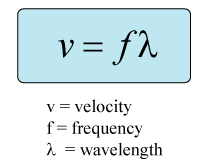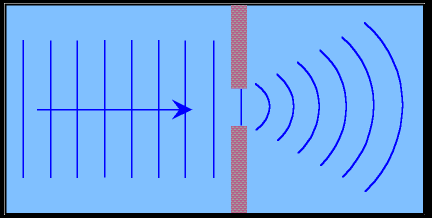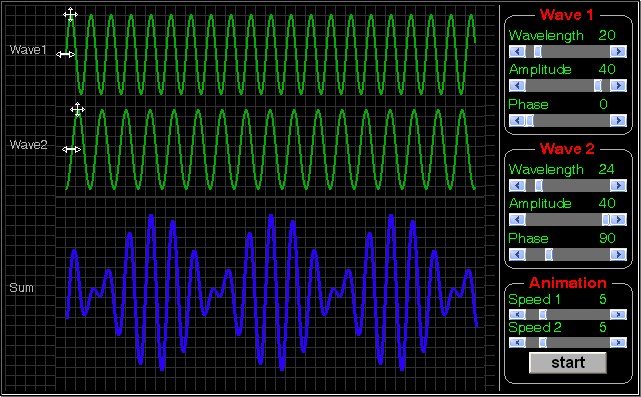velocity = (frequency)x(wavelength)

Vortex Ring Demo:! Beat the drum and send energy but not necessarily air molecules from transmitter to receiver. The actual air from the drum arrives much later than the sound.Sound speed depends upon the medium. With an explosion, you feel the vibrations through the ground before you hear the blast. The speed of sound in the ground is faster than in air, ergo you feel those vibrations with your entire body.
velocity = (frequency)x(wavelength)

Waves has several fundamental properties, meaning "things that all (types of) waves do...." Some of these are:
- transfer energy
- obey Huygens's principle
- reflect
- refract
- interfere (superimpose)
- diffract
- add to create beats
- exhibit the 'Doppler effect
- add to create other waveshapes (Fourier)
Huygen's principle...each point on a wavefront acts as a source of circular (spherical) waves."
In terms of straightforward propagation of circular or plane waves, one can imagine each point on the wave as a source of circular waves, propagate froward and draw a line tangent to each front to get the propagating wavefront.
Wave Reflections on string:
Demos in class included wave reflections on a long spring, a torsion wave apparatus, and a rubber rope. Thi is a simulation you can play with. Note that fixed end reflections are inverted and open end reflections are not.
Wave Pulse Reflections.: To see rflected waves, lower the damping setting. Compare reflected waves fgorfixed and open ends. Play around and have fun!
Works well showing waves reflected on a string.
BOOK ERROR: PAGE 44 Top paragraph describing sound waves in a tube. The logic is backwards. An open ended tube is like a fixed string end and a closed end tube acts like an open ended string. Think of the open ended tube as an end FIXED AT ATMOSPHERIC PRESSURE. So the reflected wave inverts at an open ended tube, like the string wave inverts at a a fixed ended string.
Wave Reflections: Off a surface.
Waves reflect off a surfcae such that the incident angle is equal to the reflected anngle.
Wave Reflection: Changing medium. Impedance Matching.
Waves changing mediums will experience a change n velocity. This will make the wavelength change as well as cause some waves to be reflected and some transmitted. Impednace matching makes the energy transfer more efficient, This is why the end of a wind horn instrument is flared, tomatch the charaecteristics of the narrow horn air collumn to open air.
Refraction of Waves:
The bending of a wave due to the speed of wave changing when changeing mediums. If the wave is incident at an angle, it bends. Thebook gives a nice exmaple of hearing distant sounds on a lake due to the speed of sound in warm air being faster than cool air.
Remember when a wave is in contact with a change in medium, some waves are reflected and some is trnsmitter. The transmitted wave will change direction.
Wave Diffraction:
Waves can bend around corners and tyhe easiest model to demonstrate why is Huygens principle as seen ion the figures below. Criteria for this phenomena is given in the book.


Wave Interference:
Superposition: The addition of Waves.
Waves superimpose on each other. They add up. A crest to a crest will makea bigger wave. A crest to a trough will make a smaller wave. The link abve explains this a bit with some nice graphics.When two sources of waves interact, they superimpose, add together, and this is called wave interference. we had some great examples in lecture. You can investicate wave interference with this simulation. Play with two sources. Increas the frequency and see where the waves add together and where they cancel out.
Review Wave Principles as they apply to sound by playing with the JAVA Applet Simulation below.
Beat Frequency:
When two signal sources have frequecnies very close to eache, a difference of 5 - 10 Hz, they will superimpose and beat together. The sound ampolitude or volume will have a frequecny that is equale to the difference bewtween the two frequencies. Instrumenst played together out of tune will beat together.

Beats are used at times to assist with tuning instruments. The proper reference tone is played and the tuning of the instrument can be adjusted until the beats disappear.Pleasant Sound Ratios:
When two signal sources have frequecnies that are ratyions such as 2:1 or 3:2, the sound outpurt is found to pleasing to our sense of sound. The 3:2 ratio for instance are fifth notes combined. Samples of the ratios and alos a way to find these ratios was shown in lecture.Musical chords are combinations of frequency ratios.
You can play with frequency ratios here.
Standing Waves:
Staunding Wave Info and Simulation.Resonance: A small driving force can cause a large reaction if the frequency of the driviing force is the same as the system it is driving.
Typical Applications
Swinging on a swing, Rocking in a rocking chair, Mass on a spring,
Even a Bridge!
Tacoma Narrows
Russina BridgeFourier Analysis: What frequecies make-up different sounds. We will look at the sound spectra from various instruments.